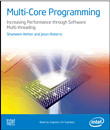Scott Wasson at the techreport.com has a short but fairly good write-up on the microarchitecture of VIAs new ‘Isaiah’ processor core, developed by their subsidiary Centaur technology. What is interesting is the part on multicore processing. Scott is quoting Glenn Henry from Centaur:
He points out that most people don’t and shouldn’t care what type of CPU they have in their PCs, so long as it gets the job done. When Centaur started, Henry says, they had to develop engineers with a different mindset, not “faster is better.” He set a series of targets involving die size limits and a ship date, and then directed his people to make the processor fast enough within those constraints that people would want to buy it.
Indeed, once you’ve absorbed the Centaur mindset, Henry’s answers to questions become somewhat predictable. Will Isaiah go multi-core? It can; it’s built that way, and Henry thinks Intel’s approach of a shared L2 cache makes sense. But he scoffs at the notion that people need multiple cores in basic computing devices right now. Henry says Centaur will go to multiple cores if it needs that level of performance or if Intel convinces people they have to have it.
It is a very interesting and different way to go about processor design. Aiming for “good enough for what people do now”. A Skoda, not a BMW, to use an old automotive analogy. But note that while in some markets “good enough” also means “bleak and boring”. But this is not necessarily the case in personal computing.
In computers, the software and system construction is what makes a PC stand out from another, not the raw performance of the processor. And as good enough in the Via case also means fairly radically low-power, you can build some cool and cool compact solutions from something like the Isaiah, provided that you absolutely want it to run a commodity OS like Windows or x86 standard Linux (which makes sense for a home machine).
If you care to do a bit more customization and create true consumer electronics, you can easily get the same features at half the power budget using an ARM, MIPS, or embedded POWER core.
The only bit that strikes me as interesting is that Henry thinks of multicore as a way to increase performance, rather than as a way to decrease power. Maybe the additional size of a second core has something do with this, but other players in the market, most notably ARM, is using multicore as a way to reduce the power consumption at a given level of performance. Could be that in the x86 world, anything slower than the current Isaiah design will just be too single-threaded slow to be viable running Windows.
 CNET (of all places) have a short article on what Montalvo Systems are up to: Secret recipe inside Intel’s latest competitor | CNET News.com. The article is a bit short on details, but it sounds like it is finally an example of a same-ISA, different-powered-cores heterogeneous multicore device in the mainstream. The idea has a lot of merit, and it will be very interesting to see the final results once silicon ships. I really believe is heterogeneous designs.
CNET (of all places) have a short article on what Montalvo Systems are up to: Secret recipe inside Intel’s latest competitor | CNET News.com. The article is a bit short on details, but it sounds like it is finally an example of a same-ISA, different-powered-cores heterogeneous multicore device in the mainstream. The idea has a lot of merit, and it will be very interesting to see the final results once silicon ships. I really believe is heterogeneous designs. If you are looking for a good popular introduction to what spam is and how it works, the
If you are looking for a good popular introduction to what spam is and how it works, the  I’ve never seen the comics at
I’ve never seen the comics at  Over at an online publication called AI Game Dev, there is an
Over at an online publication called AI Game Dev, there is an 
